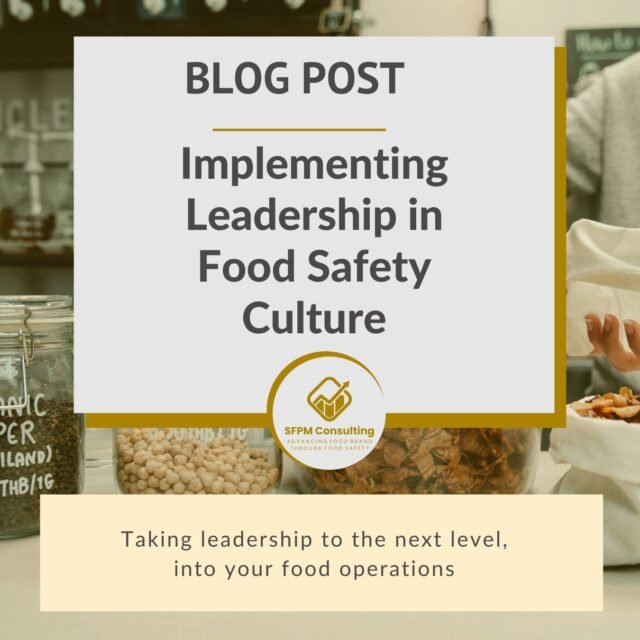[vc_row][vc_column][vc_video link=”https://youtube.com/embed/lbUJhyssiIw” css=””][vc_column_text css=””]When it comes to ensuring food safety in any organization, strong leadership plays a crucial role. Leaders have the power to shape the culture and values of their teams, and this is especially important in the food industry where the health and well-being of consumers are at stake. In this blog post, we will explore how to implement leadership in food safety culture and the steps that food safety professionals can take to become leaders, to create a culture of food safety within their organization.
1. Lead by Example
Food safety professionals must lead by example when it comes to food safety. That way, we demonstrate our commitment to food safety by following all the necessary protocols and procedures themselves. This includes practicing good hygiene, wearing appropriate protective gear, and adhering to proper food handling and storage practices. When leaders prioritize food safety, it sends a clear message to their teams that it is a non-negotiable aspect of their operations.
2. Establish Clear Expectations
We can set clear expectations when it comes to food safety. This includes setting standards for cleanliness, hygiene, and proper food handling practices. These expectations should be communicated clearly to all employees and reinforced through regular training and reminders. By establishing clear expectations, we create a sense of accountability and ensure that everyone understands the importance of their role in maintaining food safety.
3. Provide Adequate Training
Training is essential for building a strong food safety culture. As a food safety professionals, we can help our productions and operations staff by providing our team with adequate training on food safety practices, including proper handwashing techniques, safe food storage, and cross-contamination prevention. Training should be ongoing and regularly updated to ensure that employees are equipped with the knowledge and skills necessary to maintain food safety standards.
4. Foster a Culture of Continuous Improvement
As a food safety professional, we hear feedback and promote a culture of continuous improvement when it comes to food safety. This means regularly evaluating and updating food safety protocols and procedures based on new information, industry best practices, and feedback from employees.
We are building culture that encourage our teams to share ideas and suggestions for improving food safety practices, creating an environment where everyone feels empowered to contribute to the overall safety of the organization.
5. Recognize and Reward Good Practices
Don’t forget that our team is doing us a favour by following food safety programs. We need to recognize and reward employees who consistently demonstrate good food safety practices. This can be done through verbal recognition, incentives, or even a formal recognition program.
By acknowledging and rewarding employees for their efforts, leaders reinforce the importance of food safety and motivate others to follow suit.
6. Foster Open Communication
Open communication is vital for maintaining a strong food safety culture. Being the frontline leader, as a food safety professional, we can help create an environment where employees feel comfortable reporting any food safety concerns or incidents. This includes providing multiple channels for reporting, such as anonymous reporting systems, and ensuring that all reports are taken seriously and addressed promptly.
By fostering open communication, we can identify and address any potential food safety risks before they escalate. Remember to address all issues that was raised.
7. Regularly Monitor and Assess Performance
Being a leader, means we are regularly monitor and assess the performance of their teams when it comes to food safety. This can be done through regular inspections, audits, and employee feedback. By monitoring performance, leaders can identify any gaps or areas for improvement and take corrective action as necessary. Regular assessments also help leaders ensure that food safety remains a top priority and that all employees are consistently adhering to the established protocols and procedures.
By implementing these strategies, we can promote ourselves to being leaders -the leader that can create a strong food safety culture within their organization. This not only helps protect the health and well-being of consumers but also enhances the reputation and success of the business.
Leadership in food safety is not just about following regulations; it is about instilling a mindset and values that prioritize the safety of the food we consume.
What do you think about this quick leadership guide? Does this help?
We love to work with you and your team if you are facing food safety culture challenges, to help you resolve some of the challenges. And help you build a workplace that is enjoyable by the team and prioritizes food safety.
Remember, a team that has the same goals, thrives!
Click here to find a Time with Felicia Loo and discuss how we can assist.[/vc_column_text][/vc_column][/vc_row][vc_row][vc_column][/vc_column][/vc_row]

